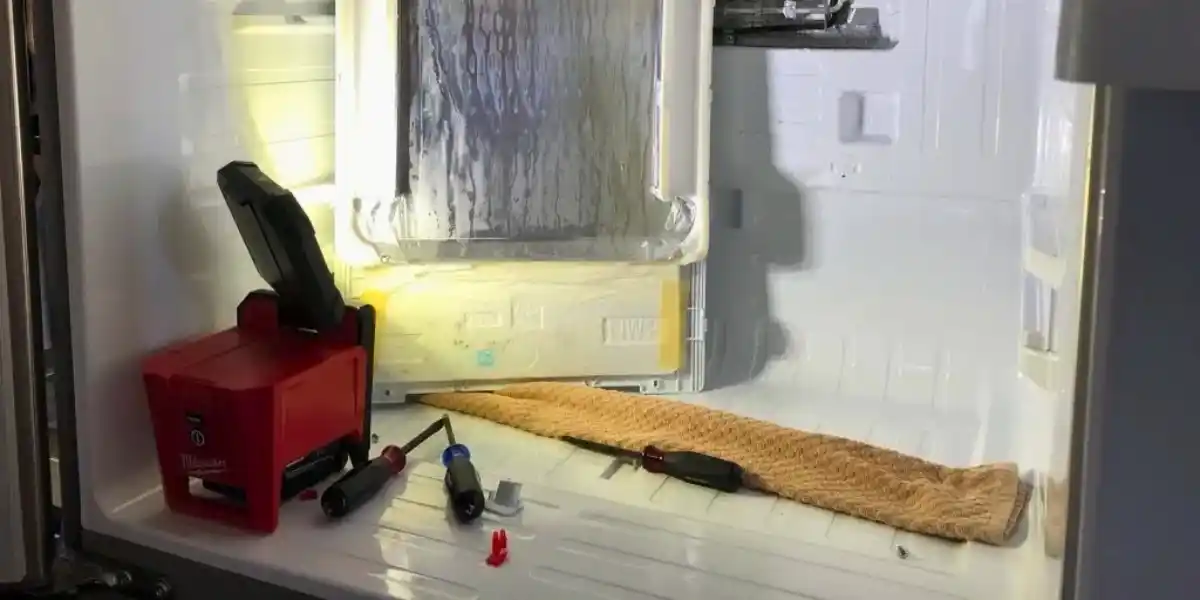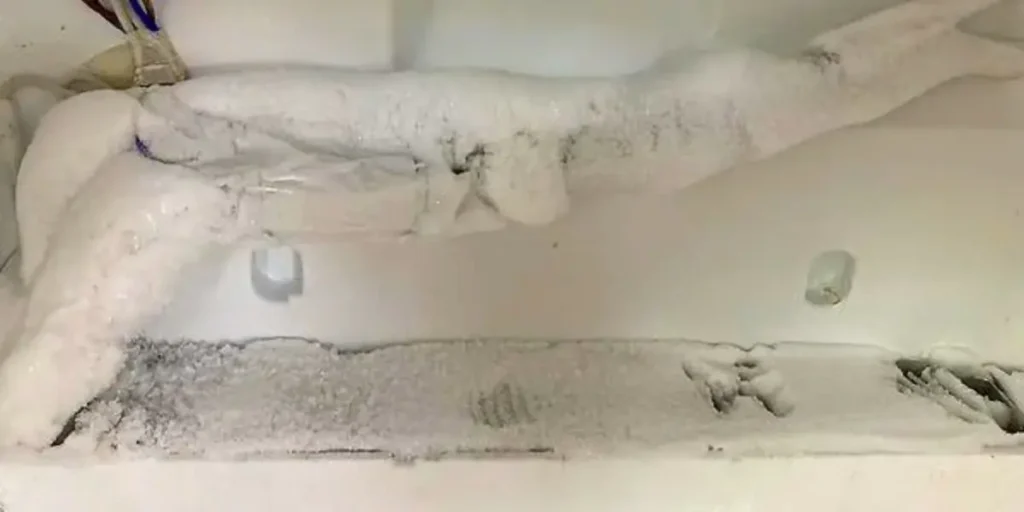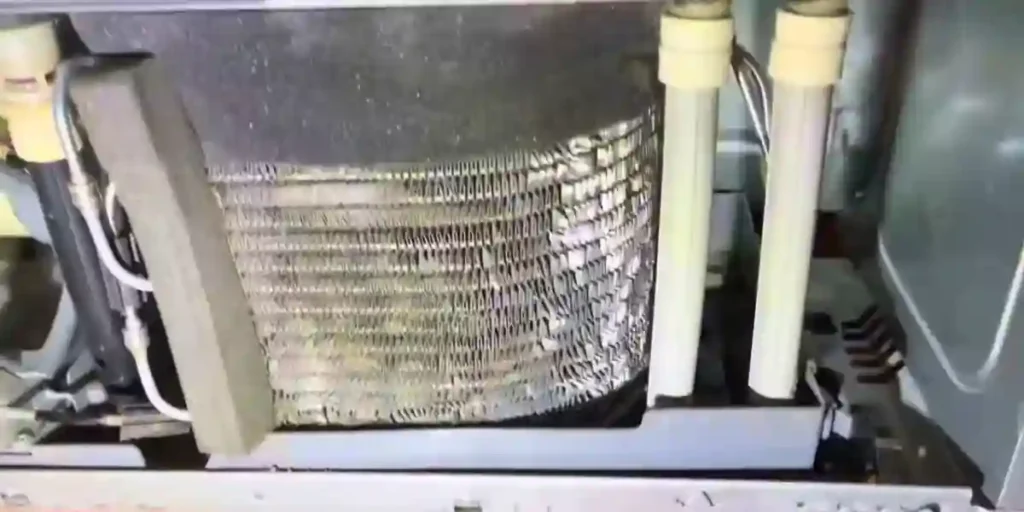
If you own a Samsung refrigerator, you may have experienced water collecting in and under the crisper drawers. This issue can be frustrating and potentially damaging to your appliance and the surrounding area.
The root cause of this problem is usually a clogged defrost drain line, a defective water entry valve, or a malfunctioning defrost drain pan. Improper leveling, excessive humidity, and other factors can also contribute to water leaks.
Let’s provide you with some tips and solutions to help you fix and prevent water leaks under the crisper drawers of your Samsung refrigerator.
Why Is Water Leaking Under Crisper Drawers of Samsung Refrigerators?
Water leaking under the crisper drawers of a Samsung refrigerator can be caused by several factors. Here are the main reasons why this issue may occur:
Clogged Defrost Drain
The defrost system in a refrigerator includes a drain tube that carries excess water into a drain pan. If this drain tube becomes clogged with debris or ice, the water can back up and leak into the crisper drawers and spill into the refrigerator.
Improper Leveling
If a Samsung refrigerator is not properly leveled, it can lead to water leaks. The front of the refrigerator should be slightly higher than the back to allow coolant to flow smoothly.
If the fridge is not leveled correctly, it can cause condensation around the condenser coils, resulting in water leakage.
Excessive Humidity
On hot and humid days, moisture in the air can contribute to water leaks in the refrigerator. This additional moisture combines with the existing water in the refrigerator and can overflow from the drain pan, leading to water accumulation under the crisper drawers.
Defective Components
A malfunctioning water entry valve or a damaged defrost drain pan can also cause water leaks. If these components are not functioning properly, water may not be directed to the appropriate drainage system, resulting in leaks.
Faulty Water Filter

If the water filter in the refrigerator is not properly installed or is old and clogged, it can cause water leaks. A damaged or incorrectly installed water filter can lead to water bypassing the filter and accumulating under the crisper drawers.
Cracked or Damaged Water Line
A cracked or damaged water line can result in water leaks. The water line supplies water to various parts of the refrigerator, including the ice maker and water dispenser.
If there is a crack or damage in the line, it can cause water to leak and accumulate under the crisper drawers.
Frozen or Blocked Water Line
If the water line becomes frozen or blocked, it can cause water leaks. This can happen if the refrigerator’s temperature is set too low or if there is a blockage in the line. The frozen or blocked water can thaw and leak under the crisper drawers.
Excessive Frost or Ice Buildup
Excessive frost or ice buildup in the freezer can lead to water leaks. When the frost or ice melts, it can result in water pooling under the crisper drawers. This can be caused by a faulty defrost system or a door seal that is not sealing properly.
Condensation
Condensation can occur inside the refrigerator and contribute to water leaks. This can happen if the refrigerator door is frequently opened or if there is a problem with the door seal. The condensation can drip down and accumulate under the crisper drawers.
Overfilling of the Defrost Drain Pan
The defrost drain pan collects water from the defrost cycle. If the pan becomes overfilled, it can overflow and cause water to leak under the crisper drawers.
This can happen if the drain pan is not properly positioned or if there is a blockage in the drain tube.
Cracked or Damaged Drain Pan
A cracked or damaged drain pan can also lead to water leaks. If the drain pan is compromised, it may not be able to hold the water properly, resulting in leaks under the crisper drawers.
Excessive Moisture from Food
Certain types of food, such as fruits and vegetables, release moisture as they decompose. If there is excessive moisture from the food inside the refrigerator, it can contribute to water leaks under the crisper drawers.
Excessive Frost or Ice in the Freezer

If there is excessive frost or ice buildup in the freezer, it can cause water leaks under the crisper drawers. This can occur if the freezer door is not closing properly or if there is a problem with the defrost system.
Damaged or Misaligned Drain Tube
The drain tube carries water from the defrost cycle to the drain pan. If the drain tube is damaged or misaligned, it can cause water to leak under the crisper drawers. This can happen due to wear and tear or improper installation.
Poor Sealing or Alignment
If the seals around the doors or the alignment of the doors are off, it can lead to water buildup.
Dripping Water Tank
If there’s a tank to store water for the dispenser, and it’s leaking, water can drip down.
Temperature Settings Too Low
If the temperature inside the refrigerator is set too low, it might cause excessive condensation.
Damaged Gasket around Crisper Drawers
If the gasket or seal around the crisper drawers is damaged, it could allow condensation.
Quick Fixes for Water Leakage Under Crisper Drawers of Samsung Refrigerator
Here are some solutions to apply when the Samsung fridge leaks water under the crisper drawers:
Clogged Defrost Drain

Clear the defrost drain by removing any debris or ice that may be blocking the defrost drain tube. You can use a pipe cleaner or a turkey baster filled with hot water to flush out the clog.
How to Defrost Drain for Stop Ice Buildup
- Unplug the refrigerator.
- Locate the defrost drain.
- Use a gentle tool like a soft brush.
- Gently remove debris.
- Pour warm water to melt the ice.
- Test by pouring a small amount of water.
- Clean up and plug the refrigerator back in.
Improper Leveling
Check the leveling of the refrigerator and adjust the front legs if necessary. Use a bubble level to ensure that the front is slightly higher than the back.
How to Level the Refrigerator
- Find the leveling legs or wheels.
- Ask for an adult’s assistance.
- Adjust the legs or wheels.
- Check with a bubble level.
- Make small adjustments if needed.
- Put the refrigerator back in its spot.
Excessive Humidity
Use a dehumidifier in the surrounding area to minimize excess humidity. This can help prevent additional moisture from accumulating in the refrigerator. Proper temperature is key for preventing leaks.
How to adjust the temperature
- Find the temperature controls.
- Set to the recommended level.
- Wait a day to adjust.
- Recheck and adjust if needed.
- Monitor for a week for consistency.
Defective Components
Check and replace defective components such as a malfunctioning water entry valve or a damaged defrost drain pan. Consult a professional technician or contact Samsung support for assistance.
How to check a Faulty Water Filter
- Check the water filter and replace it if it is old clogged or not properly installed.
- Cracked or Damaged Water Line
- Inspect the water line for cracks or damage and replace it if necessary.
- Care for Water Dispenser and Ice Maker
- Inspect the water supply line.
- Ensure the water filter is in place.
- Look for any signs of leakage.
- Replace or fix any faulty parts with an adult’s help.
- Regularly clean the ice maker and water dispenser.
Frozen or Blocked Water Line

Check the temperature setting of the refrigerator and adjust it if necessary. If the water line is blocked, use a hairdryer to thaw the line or replace it if it is damaged.
Excessive Frost or Ice Buildup
Defrost the freezer and remove any excessive frost or ice buildup. Check the door seal and replace it if it is not sealing properly. Door seals keep the cold air inside.
How to fix door seal
- Inspect the seals for cracks.
- Clean the seals.
- Determine if new seals are needed.
- Purchase the correct seals with an adult’s help.
- Follow the installation instructions.
- Test the doors.
- Make sure they seal properly.
Condensation
Check the door seal and replace it if it is not sealing properly. Use a towel to wipe away any condensation inside the refrigerator.
Overfilling of the Defrost Drain Pan
Check the defrost drain pan and empty it if it is overfilled. Make sure that the drain pan is properly positioned and that there is no blockage in the drain tube.
Cracked or Damaged Drain Pan
Inspect the drain pan for cracks or damage and replace it if necessary.
How to Regularly Inspect Drain Pan
- Locate the drain pan, usually underneath.
- Check for cracks or damage.
- Clean regularly to prevent clogs.
- Replace if damaged.
Excessive Moisture from Food
Store food in airtight containers to minimize moisture. Clean up any spills or leaks immediately.
Checking and Replacing the Water Line
Inspect the water line for cracks or damage. Replace it if necessary. Use a hairdryer to thaw the water line or replace it if it is damaged.
Defrosting the Freezer
Turn off the refrigerator and remove all food from the freezer. Allow the ice to melt naturally or use a hairdryer to speed up the process. Clean the freezer and wipe away any excess water.
Storing Food in Airtight Containers
Use airtight containers to store food and minimize moisture. Clean up any spills or leaks immediately.
Tips for Maintaining Your Samsung Refrigerator to Prevent Leaks under crisper drawers
Here are some effective tips for maintaining your Samsung refrigerator to prevent leaks under crisper drawers:
Clean the Defrost Drain Regularly
In addition to regular cleaning, it is important to specifically clean the defrost drain. Use a mixture of warm water and mild detergent to flush out any debris or residue that may accumulate in the drain. This helps ensure proper drainage and prevents clogs that can lead to leaks.
Inspect and Clean the Door Gaskets
Regularly inspect the door gaskets for any signs of wear or damage. Clean them with a mild detergent and warm water to remove any dirt or debris that may prevent a proper seal. A tight seal prevents warm air from entering the refrigerator, reducing the likelihood of condensation and leaks.
Avoid Blocking Air Vents
Ensure that the air vents inside the refrigerator and freezer compartments are not blocked by food items or containers. Blocked vents can disrupt proper airflow, leading to temperature fluctuations and excess moisture, which can result in leaks.
Monitor and Adjust Temperature Settings
Keep an eye on the temperature settings of your refrigerator and freezer. Make sure they are set to the recommended levels. Extreme temperatures can cause condensation and leaks. Adjust the settings if necessary to maintain optimal conditions.
Regularly Check and Replace Water Filters
Follow the manufacturer’s guidelines for replacing the water filter in your Samsung refrigerator. Regularly replacing the water filter ensures that it functions properly, preventing any potential leaks caused by a clogged or damaged filter.
Avoid Placing Hot or Warm Items Inside
Allow hot or warm items to cool down before placing them inside the refrigerator. Placing hot items directly into the fridge can cause condensation and excess moisture, leading to leaks. Let the items reach room temperature before storing them.
Keep the Refrigerator Well-Stocked
A well-stocked refrigerator helps maintain a more stable temperature. The stored items act as thermal mass, reducing temperature fluctuations and minimizing the potential for condensation and leaks. However, avoid overstocking, as it can restrict airflow and lead to moisture buildup.
Regularly Inspect and Clean the Condenser Coils
The condenser coils, located either at the back or underneath the refrigerator, can accumulate dust and debris over time.
Regularly inspect and clean these coils using a vacuum cleaner or a brush to ensure proper heat dissipation. This helps prevent excessive condensation and leaks.
Avoid Slamming the Doors
Be gentle when closing the refrigerator and freezer doors. Slamming the doors can disrupt the proper sealing of the gaskets, leading to air leaks and moisture buildup. Close the doors firmly but gently to maintain a tight seal.
Monitor and Control Humidity Levels
If you live in a particularly humid environment, consider using a dehumidifier in the surrounding area to reduce excess humidity. Lower humidity levels can help minimize condensation and prevent leaks.
Could a Leaking Water Issue Cause a Refrigerator to Stop Cooling?
Could a leaking water issue be the culprit behind a refrigerator cooling problem uncovered? It is possible. When water leaks inside the refrigerator and accumulates near the cooling elements, it can lead to malfunctions and affect the cooling process. Properly addressing the leak is crucial in ensuring the refrigerator returns to its optimal cooling performance.
FAQs
Can a water leak under the crisper drawers damage my Samsung refrigerator?
Yes, continuous leaking can lead to further damage, including electrical issues and structural damage to the refrigerator’s interior components.
Do I need to call a professional technician if my Samsung refrigerator is leaking water under the crisper drawers?
For simple issues like a clogged drain or uneven leveling, you might fix them yourself. For more complicated problems or persistent leaks, calling a technician is advisable.
Is water leaking under the crisper drawers a common issue with Samsung refrigerators?
While not exclusive to Samsung, water leaks under crisper drawers can occur in any refrigerator due to various reasons like clogs, improper leveling, or seal issues.
What tools do I need to fix a water leak under the crisper drawers in my Samsung refrigerator?
Basic tools like a soft brush, level, adjustable wrench, and warm water are often sufficient for common issues. More complicated repairs may require specialized tools.
Final Words
When you notice water leaking under the crisper drawers in your Samsung refrigerator, don’t fret. From clogged defrost drains to improper leveling; these issues are typically fixable with a bit of care and attention.
Following these maintenance tips can help you keep your fridge in top shape and avoid those pesky leaks.

